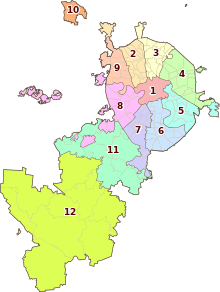Southern Administrative Okrug
| Southern Administrative Okrug Южный административный округ | |||
|---|---|---|---|
| Administrative okrug | |||
|
Prefecture building of Southern Administrative Okrug | |||
| |||
 Southern Administrative Okrug in Moscow | |||
| Coordinates: RU 55°38′N 37°40′E / 55.633°N 37.667°ECoordinates: RU 55°38′N 37°40′E / 55.633°N 37.667°E | |||
| Country | Russia | ||
| Federal city | Moscow | ||
| Districts[1] | 16[2] | ||
| Government | |||
| • Prefect | Alexey Chelyshev | ||
| Area | |||
| • Total | 132 km2 (51 sq mi) | ||
| Population (2010 Census)[3] | |||
| • Total | 1,716,808 | ||
| Website | http://uao.mos.ru | ||
Southern Administrative Okrug (Russian: Ю́жный администрати́вный о́круг, Yuzhny administrativny okrug), or Yuzhny Administrative Okrug, is one of the twelve high-level territorial divisions (administrative okrugs) of the federal city of Moscow, Russia.[1] As of the 2010 Census, its population was 1,716,808,[3] up from 1,593,065 recorded during the 2002 Census.[2]
History
The territory that comprises modern Southern Administrative Okrug attracted settlers from time immemorial, even in spite of the fact that it had historically been an unsafe area. In order to protect the borders, powerful monasteries were built. The first one was the Danilov Monastery, founded in 1271 by Prince Daniel of Moscow.
In 1593, the Donskoy Monastery was established to commemorate the victory over Khan Kazi-Girey. Villages appeared and grew near the monastery. Kolomna was one of the first villages to appear in the area. Urban development of the area began in the 16th–17th centuries, at which time the Kolomenskoye architectural ensemble was also built. The Ascension Church in particular is listed by the UNESCO as a World Heritage Site.[4]

Territorial divisions
The administrative okrug comprises the following sixteen districts:[2]
- Biryulyovo Vostochnoye
- Biryulyovo Zapadnoye
- Brateyevo
- Chertanovo Severnoye
- Chertanovo Tsentralnoye
- Chertanovo Yuzhnoye
- Danilovsky
- Donskoy
- Moskvorechye-Saburovo
- Nagatino-Sadovniki
- Nagatinsky zaton
- Nagorny
- Orekhovo-Borisovo Severnoye
- Orekhovo-Borisovo Yuzhnoye
- Tsaritsyno
- Zyablikovo
References
Notes
- 1 2 Law #13-47
- 1 2 3 Russian Federal State Statistics Service (May 21, 2004). "Численность населения России, субъектов Российской Федерации в составе федеральных округов, районов, городских поселений, сельских населённых пунктов – районных центров и сельских населённых пунктов с населением 3 тысячи и более человек" [Population of Russia, Its Federal Districts, Federal Subjects, Districts, Urban Localities, Rural Localities—Administrative Centers, and Rural Localities with Population of Over 3,000] (XLS). Всероссийская перепись населения 2002 года [All-Russia Population Census of 2002] (in Russian). Retrieved August 9, 2014.
- 1 2 Russian Federal State Statistics Service (2011). "Всероссийская перепись населения 2010 года. Том 1" [2010 All-Russian Population Census, vol. 1]. Всероссийская перепись населения 2010 года (2010 All-Russia Population Census) (in Russian). Federal State Statistics Service. Retrieved June 29, 2012.
- ↑ (Russian) History of the Southern Administrative Okrug Retrieved on October 30, 2009 Archived October 4, 2009, at the Wayback Machine.
Sources
- Московская городская Дума. Закон №13-47 от 5 июля 1995 г. «О территориальном делении города Москвы», в ред. Закона №38 от 26 июня 2013 г. «О внесении изменений в статью 4 Закона города Москвы от 5 июля 1995 г. №13-47 "О территориальном делении города Москвы" и Закон города Москвы от 15 октября 2003 года №59 "О наименованиях и границах внутригородских муниципальных образований в городе Москве"». Вступил в силу с момента опубликования. Опубликован: "Вестник Мэрии Москвы", №14, июль 1995. (Moscow City Duma. Law #13-47 of July 5, 1995 On the Territorial Division of the City of Moscow, as amended by the Law #38 of June 26, 2013 On Amending Article 4 of the Law of the City of Moscow of July 5, 1995 #13-47 "On the Territorial Division of the City of Moscow" and the Law of the City of Moscow of October 15, 2003 #59 "On the Names and Borders of the Internal Municipal Formations in the City of Moscow". Effective as of the moment of publication.).



